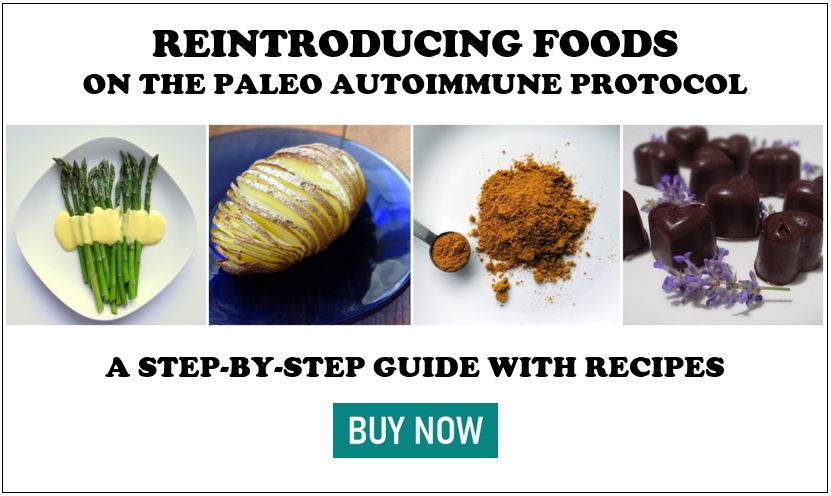
“Knowing yourself is the beginning of all wisdom.”
~ Aristotle
This Interview Series
Reintroducing Foods on the Paleo Autoimmune Protocol was my first e-book, which I published back in 2014. I realized that the reintroduction process is often the trickiest part of the AIP journey. It can be confusing, overwhelming, and hard to navigate alone. I wrote the book to guide people through, and thereafter got a nickname: Reintro Goddess. (Just kidding, but wouldn’t that be a great nickname?) I’m passionate about this process for two reasons: (1) Some people make the mistake of thinking the elimination phase of the AIP is meant to last forever. It’s not. It’s just the first step. The next step is personalizing the diet for you. (2) The reintroduction process is an experiment with you at the center, where you learn to communicate clearly with your body, and it’s incredibly empowering! Everyone’s reintroduction experience is unique. I thought it would be inspiring and educational to interview people who have been through this process themselves.
Introducing Mikaela Guimaraes
Mikaela has Crohn’s disease, and the paleo autoimmune protocol has been an essential part of her healing journey.
- How long did you do the elimination phase? I actually went paleo first after discovering Danielle Walker of Against All Grain’s work, and then slowly eliminated more things as I learned more, until I was full elimination AIP. It was fairly early in the AIP movement so there wasn’t as much information and support out there. I went fully AIP for 60 days before attempting to reintroduce anything initially.
- How did you decide that you were ready for reintroductions? When I felt that my symptoms were under control I would try and reintroduce items that I particularly missed (eggs, nightshades, butter). Unfortunately, I am often pretty disorganized, and it took quite a few failed attempts before I was really able to figure out what I tolerated. I probably would have had more early success if I had used Eileen’s book and done a more systematic approach. I also ran into some trouble when I tried to follow the 4-stage reintroduction protocol outlined by Dr. Sarah Ballantyne in The Paleo Approach. Unfortunately, I misunderstood that these were simply guidelines rather than firm rules. When I failed reintroducing foods in stage 1, I wouldn’t try anything in stages 2-4. Instead, I repeatedly went back to the elimination phase. Since then, I’ve learned that just because one category is unsuccessful doesn’t necessarily mean that another will be. One of my most successful reintroductions was white rice which is listed as stage 4. Eileen’s editorial note: In my reintroduction guide, I include the 4 stages but also an alternate reintroduction method for this reason. Most people have successes and failures mixed throughout the stages. The stages were Sarah’s best scientific guess on the easiest vs. hardest foods to reintroduce, but we are all unique and our reintroductions vary accordingly.
- What foods have you been able to successfully reintroduce? I do very well with white rice (including rice noodles), fresh legumes (green peas and green beans), and some seeds (cumin, sesame and chia). I can indulge in the occasional cup of coffee, black tea, chocolate or wine. I do fine with AIP desserts on special occasions as long as they aren’t a daily habit. Nightshades, eggs, nuts and dairy are completely off limits for me still, although I have recently started to tolerate ghee.
- Which ones can you eat regularly and which ones just occasionally? How did you discern the difference? White rice seems to be entirely safe for me as well as seed-based spices. Other things like coffee, chocolate and wine are only tolerable for me if I have them infrequently and other aspects of my health, like stress and sleep are under control. If I am a little out of balance (high stress, fighting a cold or have a few nights without adequate sleep) these treats will exacerbate symptoms and need to be avoided. It took me time to tell the difference, because both lifestyle and food can cause similar symptoms: primarily digestive upset (bloating or gas). And as a busy student and Mom to an energetic toddler, stress and sleep deprivation are often part of my life. Using a symptom diary helped me identify some of the symptoms that I was quick to brush off as “normal” for me. For example, I learned that when food is playing a part in my inflammation, joint soreness is the most common sign.
- When food reintroductions failed, what were your symptoms? I get brain fog, a general sense of “not feeling great,” low energy, headaches, sometimes skin issues or a stye, abdominal pain/upset and frequent bowel movements, and joint pain. Sometimes these symptoms will happen altogether or can isolate to one or two symptoms. The severity of my reactions depends greatly on how well I am doing in other areas of my life (as I mentioned above). These are also the symptoms that I get if I indulge too much in one of the items that I mentioned that I tolerate in moderation.
- Did any reintroduction failures later become successes? I have struggled with this. In the vast majority of cases no, although I did just finally reintroduce ghee! I still generally eat an elimination phase AIP diet beyond the items I mentioned before. I feel like my emotions about this vary and it has made me think of the stages of grief that we often go through when we lose something important, or even when we are diagnosed with autoimmune disease: Denial, anger, grief and acceptance. I have gone through these phases with my diet and diagnosis many times over the years and accept it as part of my life. Sometimes I want to ignore my symptoms and just have a glass of wine with my friends. Sometimes I am upset that I simply can’t seem to reintroduce eggs. Sometimes I feel sad about the constant ups and downs I have with my autoimmune disease. But most often I feel uplifted and grateful that I have the ability to improve my health by eating and avoiding certain foods. When I look at how my health is now compared to even 3 years ago, I feel immensely blessed that I have found a diet and lifestyle that allow me to live the life that I want and achieve my goals. It is important to me that I don’t pretend that this is easy, and I accept the part of myself that still gets angry and frustrated or even sad about certain aspects of my health and diet.
- Have you reintroduced any non-paleo foods? If yes, which ones and how often do you eat them? Yes!!!! I can have white rice and rice noodles, which makes it much easier for me to eat adequate carbs because sometimes (don’t tell anyone) I get tired of sweet potatoes. I know there are other carb options on the AIP that are delicious, but being able to eat rice makes life easier and brings sushi night back on the menu! I probably have rice (along with veggies and protein) 3-4 meals a week. I also use rice noodles and an AIP aioli recipe for the closest thing to fettuccine alfredo that I have had since college.
- Is there any food you’d never reintroduce? I am fairly anti-gluten. I would likely not go back to eating whole wheat bread and highly processed food, even if I could. I am pretty convinced that it isn’t good for anyone’s health.
- What affects your food tolerance? When I am taking great care of myself, foods that I usually can’t tolerate very often (alcohol, chocolate, coffee, even sheep’s cheese) don’t seem to bother me nearly as much! Once when I was on vacation to Spain, I dined on aged sheep cheese and Viña Verde for a week with some of the least digestive symptoms I have had since diagnosis. It is vitally important for me to remember that the AIP isn’t just a diet, but rather a protocol that takes into consideration much more than just what we do or don’t eat on a daily basis. Eileen’s editorial note: Listen to Podcast Ep. 66: The Psychology of Eating, to learn more about why food tolerance often expands on vacation and how to harness that effect at home.
- Have you ever done an AIP reset (where you did the elimination phase over again)? If yes, what was the motivation, and did you find it helpful? I actually do these quite frequently! Whenever I feel like an autoimmune flare is on the verge of appearing, or I just am not feeling great in general, I will do my own version of an AIP reset which includes a lot of AIP-friendly soups and probiotic and nutrient-rich foods. It is kind of like an AIP version of GAPS which seems to be particularly helpful with my Crohn’s disease symptoms.
- Are there any foods allowed on the AIP that you discovered you don’t tolerate? I seem to do well with most AIP foods but don’t do well with a lot of AIP-friendly baked goods or extra sugar. I would feel bloated and have brain fog whenever I made AIP-friendly cookies or treats. Now I make sure that I have plenty of company around to help me eat treats when I decide to make them! As with other things that seem to bother me, treats are tolerated better when I have sleep and stress well controlled.
- With Crohn’s disease, I know many people have to adapt their vegetable intake – either in quantity, type, or in the way it’s cooked or prepared. Is this true for you? When I was first diagnosed with Crohn’s disease my doctor recommended eating bread, rice, crackers, and no vegetables or fat. He was worried about the abrasiveness of fiber. When I first began the AIP I was worried about eating so many veggies for this reason, while instinctively I knew that I needed the nutrition that they provided. Reading The Paleo Mom’s “Fiber Manifesto” cleared up a lot of myths about the abrasiveness of fiber and helped me understand the mechanisms involved in eating vegetables. I do find that when I am symptomatic I do a lot better with cooked vegetables especially in soups. I avoid fresh vegetables when I am symptomatic, but otherwise I can now enjoy a serving-bowl-sized salad as much as the next girl!
- What was the hardest part for you about the reintroduction process? Two parts are challenging for me: The first is how similar a food reaction can be to a stress or lack-of-sleep reaction. The second is the realization that there are some delicious, nutrient dense whole foods that are likely to be intolerable for me for the indefinite future. I asked a question about this on Chris Kresser’s podcast and his answer was empowering and uplifting. I go back to that when I am feeling particularly frustrated with aspects of my health or diet. One of the key points for me in his response is about our definition of health, and how maybe health isn’t so much about an absence of symptoms or disease but rather the ability to live our dreams. The AIP, and the research I have done to improve my health in all aspects, has returned a level of functioning that has allowed me to do things that I never dreamed of being able to do when I was at my sickest. If that means that I can’t ever eat scrambled eggs with salsa, well, I guess that is OK with me.
- What’s your advice for people contemplating reintros, or just starting their own reintroduction journey? Be patient, methodical, fearless and forgiving. For me, reintroductions (especially failed ones) brought up a lot of emotions that I thought that I had overcome about my diagnosis. Accepting and forgiving myself for my anger, frustration and sadness was important, while also maintaining hope and recognizing the progress that I had made. I have heard critics say that the AIP is overly restrictive, but the ultimate goal of the autoimmune protocol is for us all to achieve our version of health, while eating the widest variety of nutritious foods possible. Reintroductions are not something to be afraid of and are a vital part of the AIP and the healing process. Also, it is crucial to remember that this AIP journey doesn’t have a finish line and that health is a constant work in progress, not a destination that we can reach.
One Last Word of Advice
Each person’s food reintroductions are unique, so don’t expect your results to be the same as above, even if you share the diagnosis. It’s fun to learn about each other’s experiences and be encouraged by them, but this is all about learning to listen to your own body. Use the resources below to learn how to do the reintroduction process yourself.
Paleo AIP Reintroduction Resources









